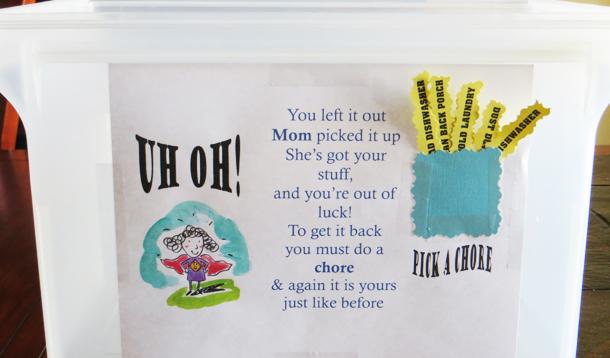
As mothers, we should be used to toys being stranded all over the house. Tonka trucks and Barbies litter our perfectly (or imperfectly) polished wood or carpeted floors, begging to be picked up. It doesn’t matter how many times we’ve made the rounds that day; there’s no end to the clutter.
I began to have meltdowns over the disarray; especially when I’d picked up the same toy five times. I couldn’t understand why I had to tell everyone, including my husband, to pick up after themselves repeatedly and see zero improvement. Did they not respect me? Was I destined to be the household maid forever?
I decided to put my foot down after finally having enough. I’d already tried rules. Pick up your toys before dinner. Put your shoes in the closet when you take them off. Put your dirty laundry in the hamper. Nothing worked; they still left things lying around—even after frequent time-outs. Even my husband—who’s always tried—still failed. Sunglasses and hats on each end table. Dirty laundry on the floor, feet away from the hamper.
Exasperated, I started doing some research to find a solution and found an interesting idea on Pinterest. The “Uh-Oh” chore box. It’s a medium sized container with a sign clearly explaining the rules: For each item not picked up or left behind, it went in the box. In order to get your item back, you had to pick one of the slips of paper with options for chores. I wondered momentarily if a medium sized box would be large enough, but I went ahead and made the box with a few pretty pieces of paper and thoughtfully chosen chores. It only took about ten minutes; a container I’d found in our garage, printer ink and paper I already had available, and voila! I had the “Uh-Oh” chore box.
After implementing our new house rule, I found myself picking up stray items with glee rather than irritation. You see, the box had several chores I hated to do as options to get the toys or items back: folding clothes, doing dishes, dusting, cleaning up the back porch. Go ahead, forget to pick up your toys before dinner. You’ll pay! Go ahead, forget your favorite shorts on the floor, right next to the dirty laundry hamper—they’ll never get washed! The evil mommy thoughts took over my brain as I reveled in silence at my new plan of action.
I was surprised at how easily everything went according to plan. Everyone forgot to pick up after themselves, and the box was brimming with toys and personal items. I happily explained over and over what that meant for each family member—work! My kids took it on like it was a game, and it worked like a charm. They knew if they left their favorite toy out, I would direct them to their appointed task before they could get it back.
I had to read the chores to my youngest child, who can’t read at all yet—but he excitedly got to pick the chore himself, as if he was picking a prize from winning a game (if you have children who can’t read, also try putting pictures of the chore on the slips). I also had to assist him with his chore, but it was a fun learning experience and before long if he forgot and set something down without putting it away, I gave him the look. He’d quickly scamper to pick his toy up, knowing he’d have work to do otherwise.
My daughter rolled her eyes at first when I confiscated her items, but I could tell the challenge presented by the box excited her a bit and she participated without too much of a fuss. The box concept always won because when she wants to play with something, she wants to play with it now, which was impossible unless she put her toys away.
My husband was the one who picked up on the idea last (go figure). I guess this shows it’s easier to teach children new and healthier habits than it is adults. Eventually, he also learned to put his things up after he’d done one too many loads of laundry, and the fact that he participated showed the children it was an equal opportunity household; we all must work together to keep our space clean.
As parents, we must to learn to adapt and thrive in each new stage with our children. As my kids grow, I find new challenges every day that arise—and I have to be prepared for battle. If we want to raise successful and happy kids, we have to learn how to create a healthy and successful home. The “Uh-Oh” box taught my children not only that I wouldn’t be their constant maid, but that they had to learn how to clean up after themselves and respect other’s space. They had to take care of their personal items, or they would be taken away. If they didn’t follow the rules, they would have to take on additional responsibilities outside of their usual realm of chores, thus paying the consequences of their actions.
It only took a few weeks, but my house became cleaner—at first because I had help doing the chores, and then just because there was less disorder everywhere. I wasn’t as annoyed because I didn’t have to nag everyone constantly. The kids were happy because deep down, kids want to be held accountable. My husband was happy because I’d come up with a resolution, without complaining.
I learned that the most effective plan of action is a silent one: to quit complaining, get creative, and find a true solution.